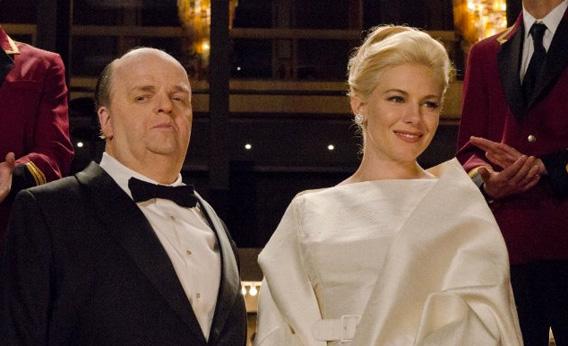The woman at the cold heart of The Girl (HBO, Saturday at 9 p.m. ET) is the actress Tippi Hedren, the ice-sculpture blonde of The Birds and Marnie. When deciding how great Hedren’s talent is, you should of course consider those two Alfred Hitchcock films. You might also weigh her performance in this 1963 interview, conducted in support of the former film, seemingly in a public park. Question: “Is Mr. Hitchcock a difficult man to work with?”
The pause Hedren takes before delivering her answer is so very brief that it is likely imperceptible to viewers innocent of the more difficult truths about Mr. Hitchcock. But it is there. “Is Mr. Hitchcock a difficult man to work with?” Nanopause. “Not at all …” Hedren then proceeds to bang out boilerplate as convincingly as any good starlet at a dumb junket—until a casual flock of pigeons ambiguously undulates behind her. Deeply startled, she must fight back a grimacing giggle before hacking out a conclusion: “He’s wonderful to work with.” And then—and this is evidence that Hedren is not an actor of the first rate—you see her throat cluck: She visibly swallows the lie.
This HBO original—clean and smart and dull, adapted by director Julian Jarrold and screenwriter Gwyneth Hughes from a book by film historian Donald Spoto—is about how very unwonderful a working relationship Hedren and Hitchcock had. Toby Jones plays the slavemaster of suspense; he captures with marvelous precision the glutinous rotundity of Hitchcock’s vowels, but his jowls leave something to be desired. Sienna Miller portrays the actress, the nominal heroine, as a very pleasant, rather bland person further hollowed out by her industry, and I cannot tell whether the portrait reflects Miller’s interpretation of her character or her limitations as a performer.
Perhaps it’s a weakness of the part? The Girl’s dramatic motion is not that of a doll who gains the strength to the leave the house but of a well-adjusted individual exhausted by the escalating indiscretions of a total creep. At the beginning, Hitch, at home with his wife (played by Imelda Staunton) spots an alluring model in a TV commercial and immediately knows that she must star in his “most ambitious movie ever”—a tale of nature versus man at Bodega Bay.
Patron and muse go to lunch and get to work. He seeks to control her. It is easy to forgive him some excesses—40-odd takes of a scene, more than a few pecks on Hedren’s face from an avian extra. If you can’t treat humans like puppets, then what is the point of making movies? But other, more obviously slimy offenses escalate: gentle flirting, moderate leering, filthy limericking, forceful groping, open insistence on erotic submission: “From now on, I want you to make yourself sexually available to me at all times.”
Men who make movies have been saying such things to the women who appear in them since Thomas Edison patented the Kinetograph, and not a few of the all-time great directors are among them; ask the ghost of any given hat-check girl in a Howard Hawks picture. But Hitchcock is Hitchcock, and I do believe I once attended an academic lecture on “Freud, Hitchcock, and the Micturating Penis.” Hitchcock and sexual obsession go together like Kim Novak and sidewalk pavement.
It would suffice for a movie about Howard Hawks or Orson Welles or Ed Wood to tell a good story. It is unclear that The Girl is a good story; an otherwise literate viewer who’d never seen The Birds would be left in the dark by its decontextualized chatter about Hedren’s character’s motivations. But a movie about Alfred Hitchcock becoming fixated with an actress and changing her hair and clutching a cigar that is not just a cigar must necessarily engage with film in a history-of-cinema kind of way.
On some level, the woman of The Girl—the referent of the cool title—is manifestly a force of nature and fact of art, as in Godard’s maxim about the only two things you need to make a movie—“a girl and a gun.” This story does not brandish firearms, but in the first act, it lavishes attention on the weapon of the camera—many glimpses of male-gaze ray-guns. The Girl treats Hitchcock as a sadist who behaves as if the purpose of his medium is to steal souls. “It’s like he wants to get inside me,” Hedren says late in the film. She’s talking about her eyes.
